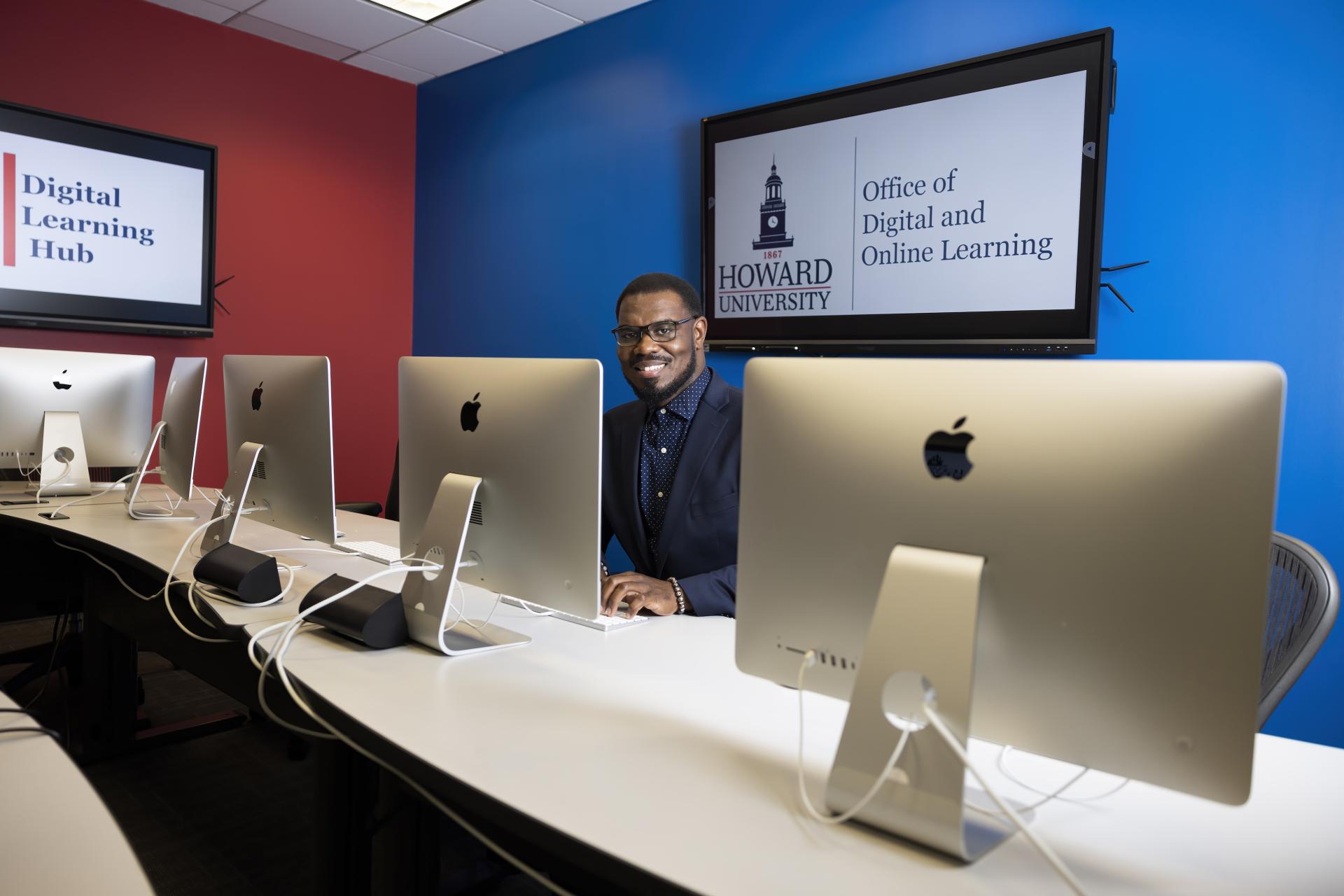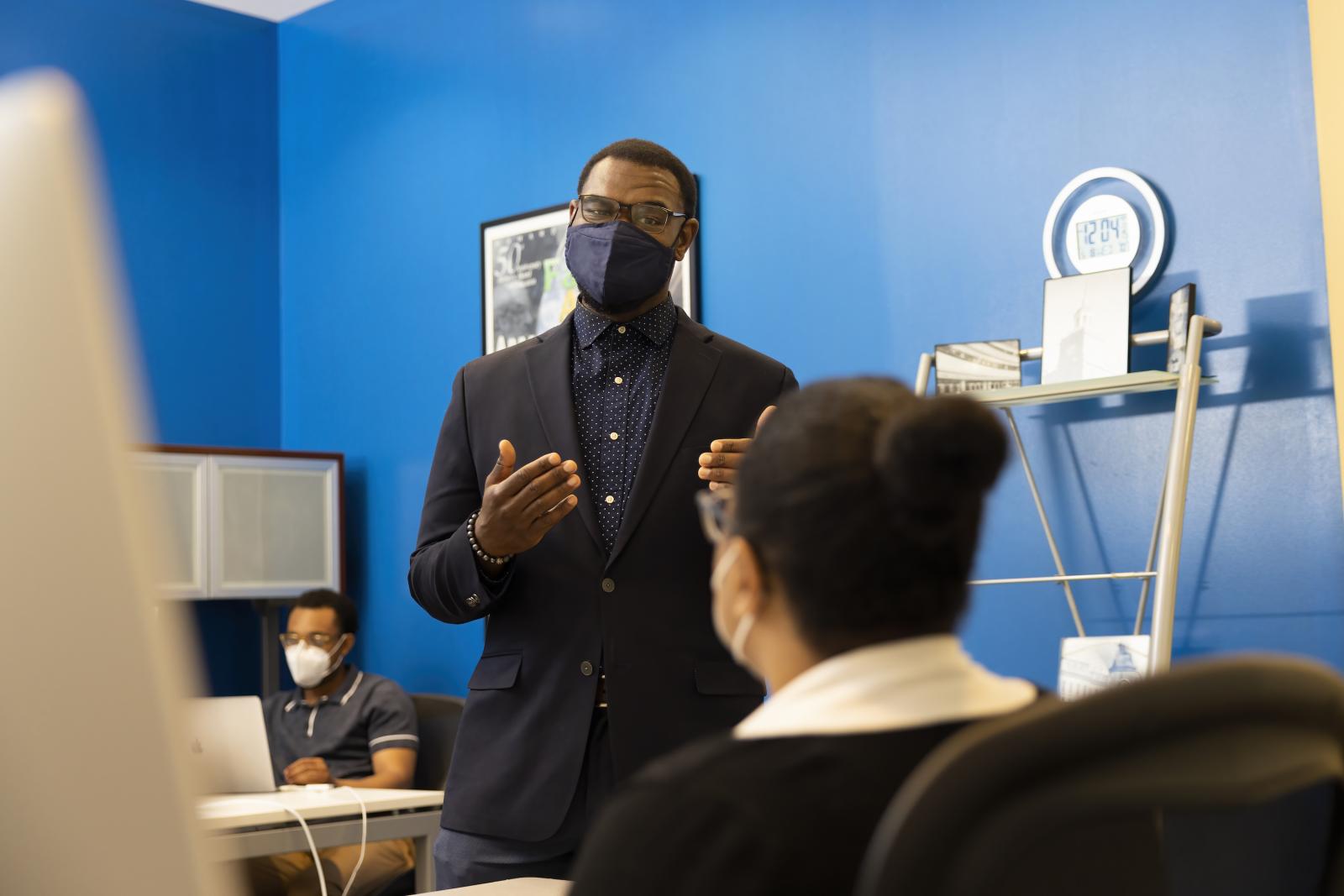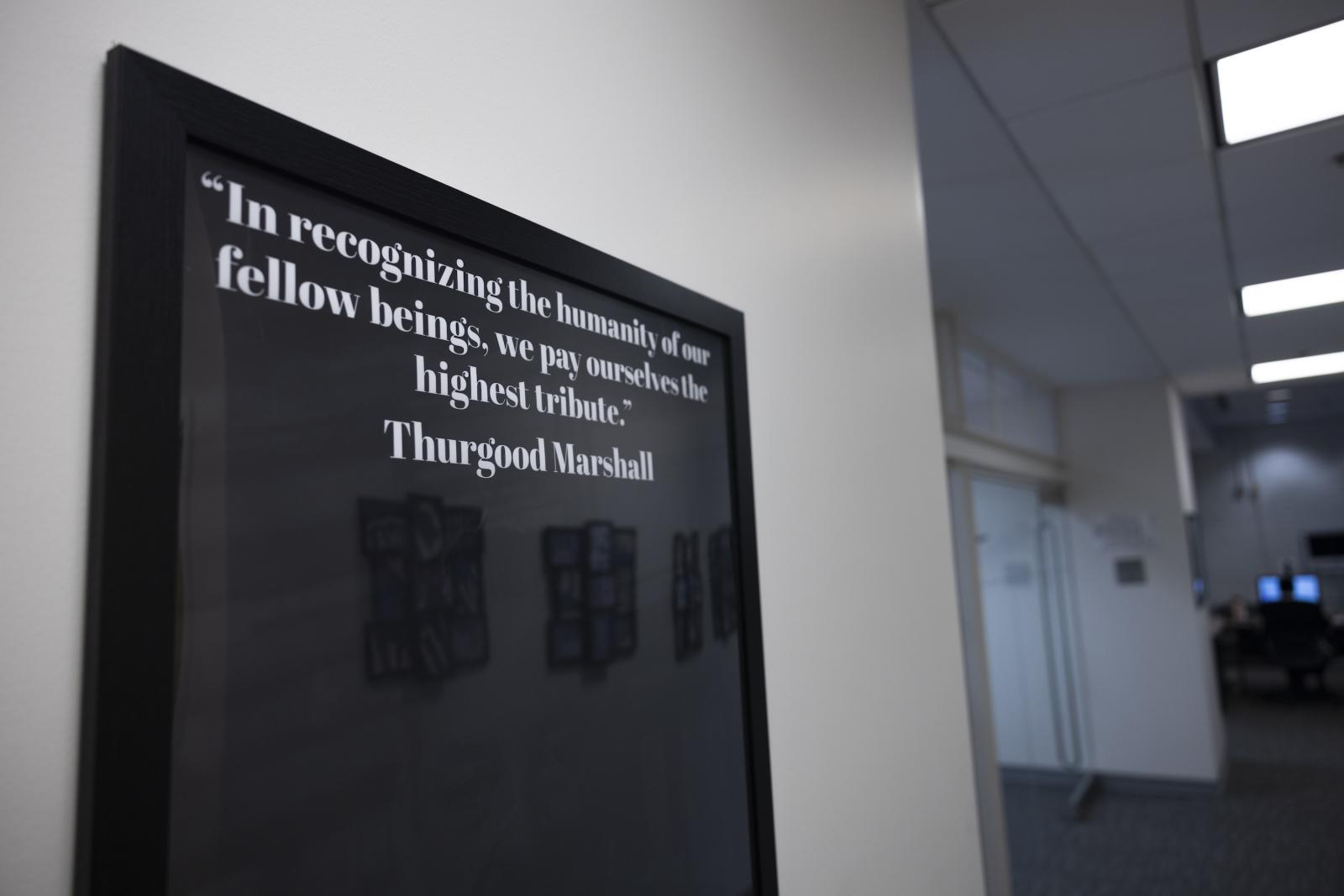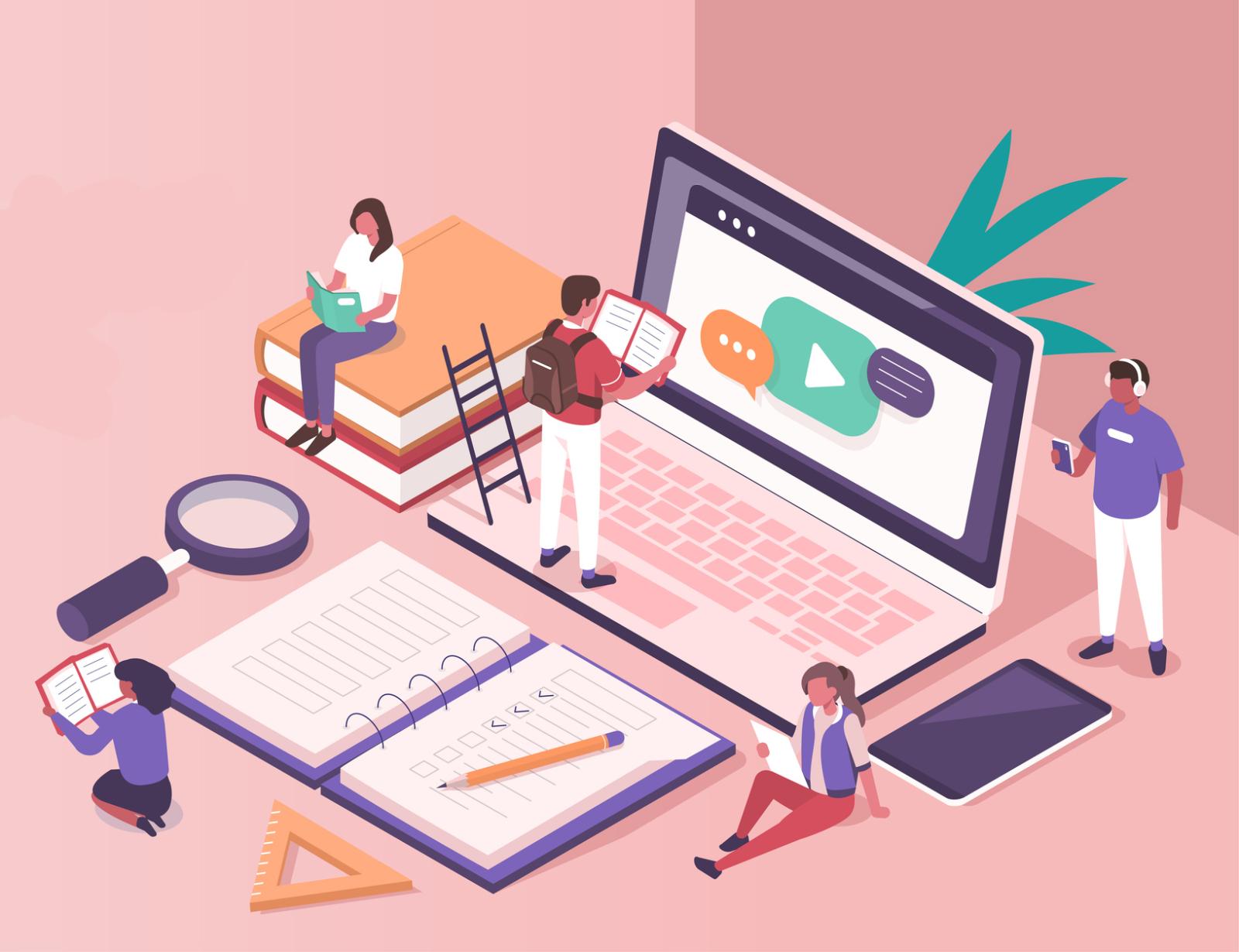For years, Morris Thomas, PhD, watched industries like banking, food service, real estate, and more transform as new technologies revolutionized the way they did business. Higher education, on the other hand, was slower to change.
“A lot of times, unfortunately … we live in [a higher] education bubble,” Thomas says. “We feel like things are unique to us because it’s education. But if you look across all industries, technology is an essential requirement.”
But COVID-19 compelled colleges and universities to adopt the technologies they had long hesitated to fully embrace.
“Higher education as an industry would not be here had it not been for technology. We would not have survived the pandemic,” Thomas says. “For us to be naïve to think that we’re just going to go back to what was [before], when [technology has proven so] valuable … would be a grave mistake.”

Morris Thomas, PhD, director of the Center for Excellence in Teaching, Learning, and Assessment at Howard, sits in the training lab.
Teaching the Teachers: Faculty Training During the Pandemic
Thomas, who came to Howard in July 2020, oversees both the Center for Excellence in Teaching, Learning, and Assessment (CETLA) as well as the Office of Digital and Online Learning, which are housed within the Office of the Provost. During the pandemic, as the University had an urgent need to bolster its online and digital learning capabilities while simultaneously training instructors to use these resources, Thomas’s distinct roles came to occupy a critical intersection of innovation.
“I am fortunate to have to have leaders like Dr. Anthony K. Wutoh, provost and chief academic officer, and Okianer Christian Dark, associate provost of faculty development, as well as the contributions of the CETLA team,” Thomas says.
CETLA offers a wide variety of developmental resources for faculty, including courses on learning management system essentials, which covers how to use Blackboard or Canvas, which the University is transitioning to; best practices in distance learning; tutorials on how to record classes, how to introduce polling questions, how to enhance classes with video and more. CETLA also offers morning and evening office hours to answer questions from faculty members.

One of the most popular and important resources during the pandemic was Fresh Start, a CETLA designed, self-paced guided course that provides instructors with best practices for initial remote course design and delivery. Tracy Whitaker, DSW, ACSW, associate professor and associate dean for academic and student advancement in the School of Social Work, admits to being skeptical before she took Fresh Start. It was Winter Break between the Fall 2020 and Spring 2021 semesters. Faculty members and students alike were beginning to grow weary of online classes, and she was reluctant to invest time on a training that might not make a significant difference.
“I was really pleasantly surprised. The way the course was set up, it was easy to [watch] the module [and] immediately implement [what I learned],” Whitaker says. “What the course really helped me do was understand the responsibility of the instructor to make sure that students aren’t struggling to get information.”

Fresh Start helped Whitaker cultivate a better and more user-friendly digital experience for her students at a time when they needed it most. From posting her syllabus in multiple formats (as a PDF, as a Word document, and directly on Blackboard) to regularly updating students’ digital gradebook, the instructions and recommendations she received from Fresh Start allowed students to stay organized and engaged. Oftentimes, the changes she made after taking Fresh Start involved small details she had never considered before that wound up making all the difference to her students.
“There was some fatigue that we were seeing a year later [after the pandemic started]. In [Spring 2021], I just [noticed] that the students were tired. They were tired of the Zoom calls. They were tired of looking for information. [I appreciated] anything that made [things] a little bit easier,” Whitaker says. “It’s really eye-opening to learn how your students are engaging in your course.”
Whitaker taught the same class, Human Services Administration, in Fall 2020 and Spring 2021 immediately before and after taking Fresh Starts. There was a noticeable difference in how students rated her course after she implemented the lessons from her training.
“I never received feedback on how my course was organized until then. And students were like, ‘It was the easiest course to navigate,’” Whitaker says. “It was not my innovation. I just did what the Fresh Starts course told me to do. I was really shocked that it made such a difference with the students.”
It’s really eye-opening to learn how your students are engaging in your course.”
Bringing Digital Tools to Howard’s Physical Campus
Enhancing digital offerings requires investing and revitalizing the physical infrastructure on campus. Thanks to a $240,000 grant from the Bill and Melinda Gates Foundation, Howard was able to create a digital learning hub, “a space to implement, adopt, and train [faculty] on new digital learning tools,” Thomas says. The hub is equipped with touch screens with whiteboard capability. It is outfitted with Mac and PC computers. There is a green screen suite and digital recording studio so Howard faculty and staff can create rich multimedia content in house. The hub is located at Wonder Plaza on Georgia Avenue.
“You need physical and virtual spaces to be able to do this work,” Thomas says.
Thomas’s vision emphasizes the “digital” component of the Office of Digital and Online Learning. He sees a future Howard education that combines in-person classroom instruction with a variety of digital technologies so Howard students can be in a virtual space even when they are still physically on campus.
For example, Thomas envisions a time when the College of Medicine curriculum includes augmented and virtual reality simulations so medical students can get experience performing surgery without cutting into an actual patient in the operating room.
Augmented reality would give Howard students an edge, according to Thomas. By giving them more opportunities to practice, they would gain a “competitive advantage” compared to students who don’t have those opportunities.
You need physical and virtual spaces to be able to do this work.”
At the end of the day, Thomas believes the institutions of higher education that will thrive in the future require both an expansion of their digital and online teaching capabilities as well as a center that emphasizes faculty development and mastery over all teaching modalities.
“[Throughout its history], Howard has done many, many things well. I want technology to be just another thing that we do well,” Thomas says. “I would like us to be prepared and ready [to leverage new technologies] and our faculty to be well versed across modalities and comfortable with technology.”
Investing in More and Improved Online Educational Experiences

Even before the pandemic, Howard emphasized virtual learning opportunities and sought to expand its digital offerings. In fact, online instruction was a key component of the first pillar, “enhance academic excellence,” of the five-year Howard Forward Strategic Plan published in 2019. Howard has recently launched and is planning for further expansions of its online educational offerings.
In January 2022, Howard launched a part-time online Master of Social Work degree in partnership with 2U, Inc., a global leader in education technology. A full-time online program will be offered starting in September 2022. The Office of Digital and Online Learning also helped launch a digital Master of Accountancy and Master of Science in Finance that will be offered for the first time beginning this Summer.
According to Mariko Carson, EdD, manager for specialty graduate programs and partnerships, School of Business faculty members have used the digital learning hub to record sections for these new online degree programs.
“I’m excited about the versatility of what this system has to offer. It’s ultimately going to make our students more technologically savvy,” Carson says. “With CETLA and the Office of Digital and Online Learning, they are ensuring that we are establishing quality courses for these programs.”
Coming up, Howard is looking to offer an online degree-completion program for those who left Howard having gained 60 or more credits but failed to earn their degrees so they can graduate from Howard without having to uproot their lives to come back to Washington, D.C.
Howard has also offered courses online for disadvantaged high school students who can earn college credits and give them a boost in their pursuit of going to college. In partnership with the National Ed Equity Lab, New York City students have taken a class in criminal justice and students in Flint, Michigan have taken an environmental justice course.
“Ultimately, technology expands our reach,” Thomas says. “And I’m not only speaking of online courses.”
During the pandemic, conducting classes online allowed students across the country and around the globe to continue to receive a Howard education. Thomas believes that technology will not only expand access to a Howard education for people who are not present on campus, but it will unlock the greater potential of a Howard education and multiply the benefits students receive from receiving a degree from the University.
Article ID: 831




